Top Pain Points Companies Face with Furniture Outsourcing. And How to Overcome Them
This report explores the latest trends, statistics, and best practices in vendor management within the furniture industry, offering actionable insights to help businesses optimize supplier relationships and achieve their strategic goals.
2/3/20253 min read
Top Pain Points Companies Face with Furniture Outsourcing. And How to Overcome Them
This report explores the latest trends, statistics, and best practices in vendor management within the furniture industry, offering actionable insights to help businesses optimize supplier relationships and achieve their strategic goals.


Leverage Expertise
In today’s competitive furniture market, access to skilled craftsmanship, advanced materials, and innovative manufacturing methods is essential. Outsourcing production to experienced Vietnamese vendors allows brands to create high quality, trend-forward furniture without the burden of running in house factories. Partnering with seasoned suppliers helps companies respond quickly to shifting consumer preferences and stay ahead of design trends.
Enhance Operational Efficiency
Strategic vendor partnerships streamline product development by optimizing resources and lowering overhead. This increased efficiency shortens lead times, reduces material waste, and allows your internal team to focus on core strengths like product design, branding, and customer engagement. Coordinated vendor management also ensures projects stay within budget and timeline, both critical in today’s fast paced furniture retail landscape.
Maintain Quality Control
While outsourcing can create distance, effective vendor management maintains control. Clear product specifications, detailed technical drawings, regular quality checks, and performance reviews ensure that each product meets your brand’s standards and complies with global safety and durability requirements. Strong oversight guarantees consistency and supports your long term brand reputation.


Key Statistics in Furniture Vendor Management
Understanding the current industry landscape is essential for identifying strengths, gaps, and areas of improvement:
Global Market Growth:
The global furniture market is projected to surpass $850 billion by 2026, driven by rising demand in both residential and commercial sectors. To meet this demand, brands increasingly rely on outsourcing to manufacturers in countries like Vietnam, India, and Eastern Europe, balancing cost with craftsmanship and quality.
Vendor Dependence:
As of 2024–2025, over 70% of furniture brands work with three or more manufacturing vendors to diversify risk and scale production. Managing multiple relationships can be complex, emphasizing the need for strong communication, clear documentation, and consistent follow up to ensure cohesive execution across product lines.
Quality & Compliance Issues:
More than 60% of companies in the sector have experienced delays or quality issues due to weak vendor oversight or inconsistent specifications. These issues highlight the importance of setting clear quality benchmarks, implementing inspection processes, and holding suppliers accountable through service level agreements (SLAs) or quality assurance programs.
Trends Shaping Furniture Outsourcing
1. Shift to Full Service Vendors
Instead of engaging separate vendors for components like upholstery, hardware, and assembly, companies are opting for full package manufacturers who manage end to end production. This reduces lead times, simplifies coordination, and ensures better product consistency.
2. Emphasis on Sustainability
Sustainability is a growing concern for both consumers and regulators. Surveys from 2024 show that 70–90% of consumers prefer brands that prioritize environmentally responsible practices. As a result, businesses are selecting vendors who use certified materials, low VOC finishes, and ethical labor practices, aligning production with broader ESG goals.
3. Focus on Product Safety & Certification
With increasing regulatory pressure in export markets such as the EU and US, ensuring compliance with safety standards (e.g., REACH, FSC, CARB Phase 2) has become critical. Brands now require lab testing, documentation, and certifications as part of their vendor onboarding and product approval processes.
Best Practices for Furniture Vendor Management
Vendor Performance Monitoring
Establish clear KPIs (e.g., on time delivery, defect rate, cost variance) and review them regularly. Site visits, product inspections, and documentation help identify issues early and enable proactive resolution.
Clear and Consistent Communication
Use shared platforms, bilingual documentation, and regular video calls to align expectations and minimize misunderstandings. Transparency builds trust and improves execution.
Long Term Strategic Partnerships
Rather than transactional relationships, leading companies are investing in long term vendor partnerships to enable collaborative development, innovation, and sustained growth.
Future Outlook
AI and Automation
AI tools are already supporting demand forecasting, inventory planning, and supplier scoring. By 2026, widespread adoption will allow businesses to make faster, smarter sourcing decisions and streamline procurement.
Sustainable Supply Chain Practices
With ESG goals becoming standard, companies are integrating carbon tracking, waste reduction programs, and social compliance audits into their sourcing strategies. Suppliers that align with these values will stand out.
Data Driven Decisions
Analytics platforms can track vendor performance trends, flag risks, and recommend sourcing adjustments. Companies embracing data will gain greater control, visibility, and long term efficiency.
The future of vendor management in the furniture industry will be shaped by technology adoption, environmental responsibility, and consumer demand. Key developments include:
Conclusion
For furniture businesses, managing outsourced manufacturing relationships is no longer just about minimizing cost. It’s about strategic alignment, quality assurance, flexibility, and long term value creation. As the industry evolves, those who invest in strong vendor management practices won’t just keep up. They’ll lead.
Company
Vietnam
reiphan2123@gmail.com
+84 - 0902 984 853
© 2025. All rights reserved.